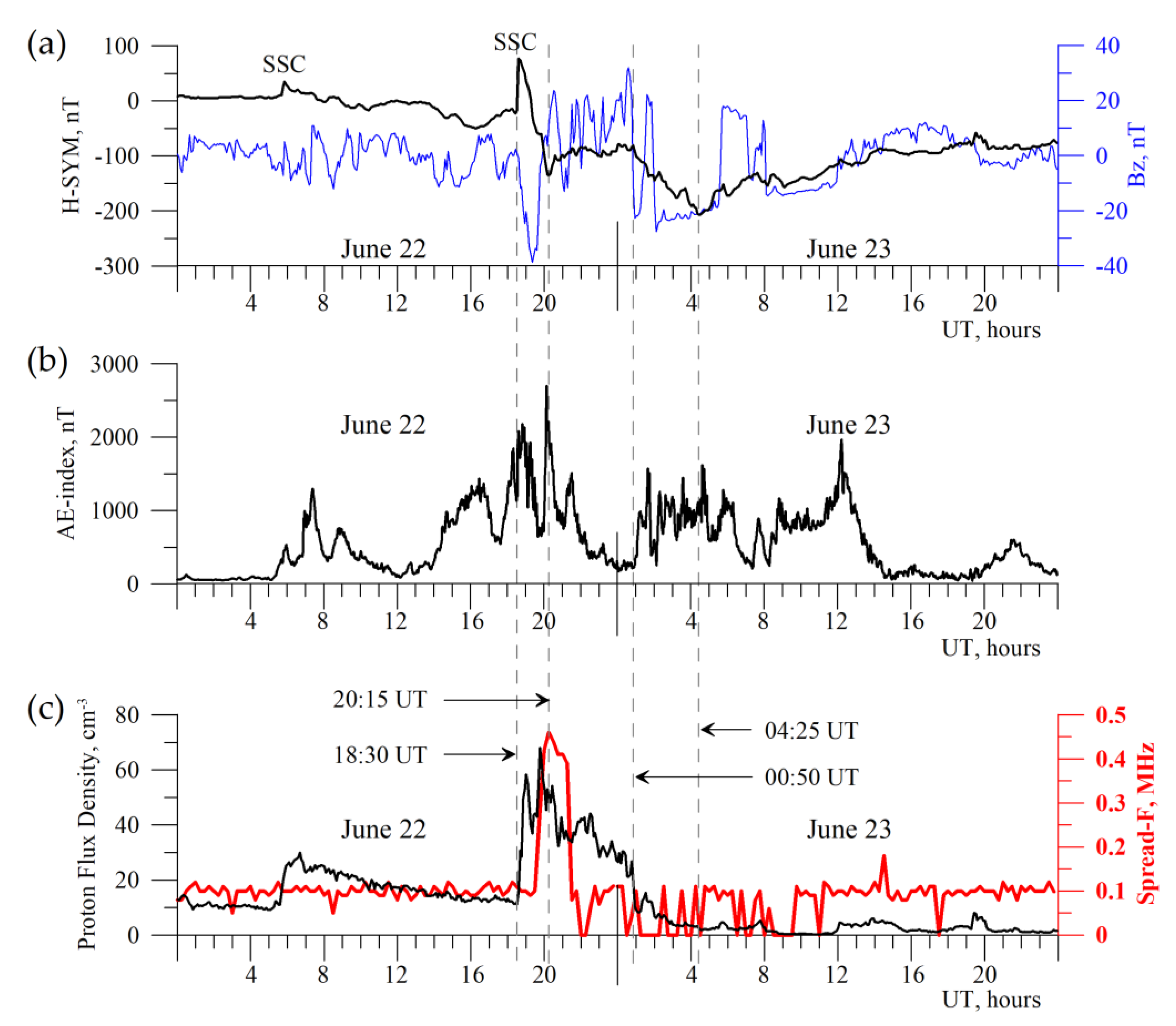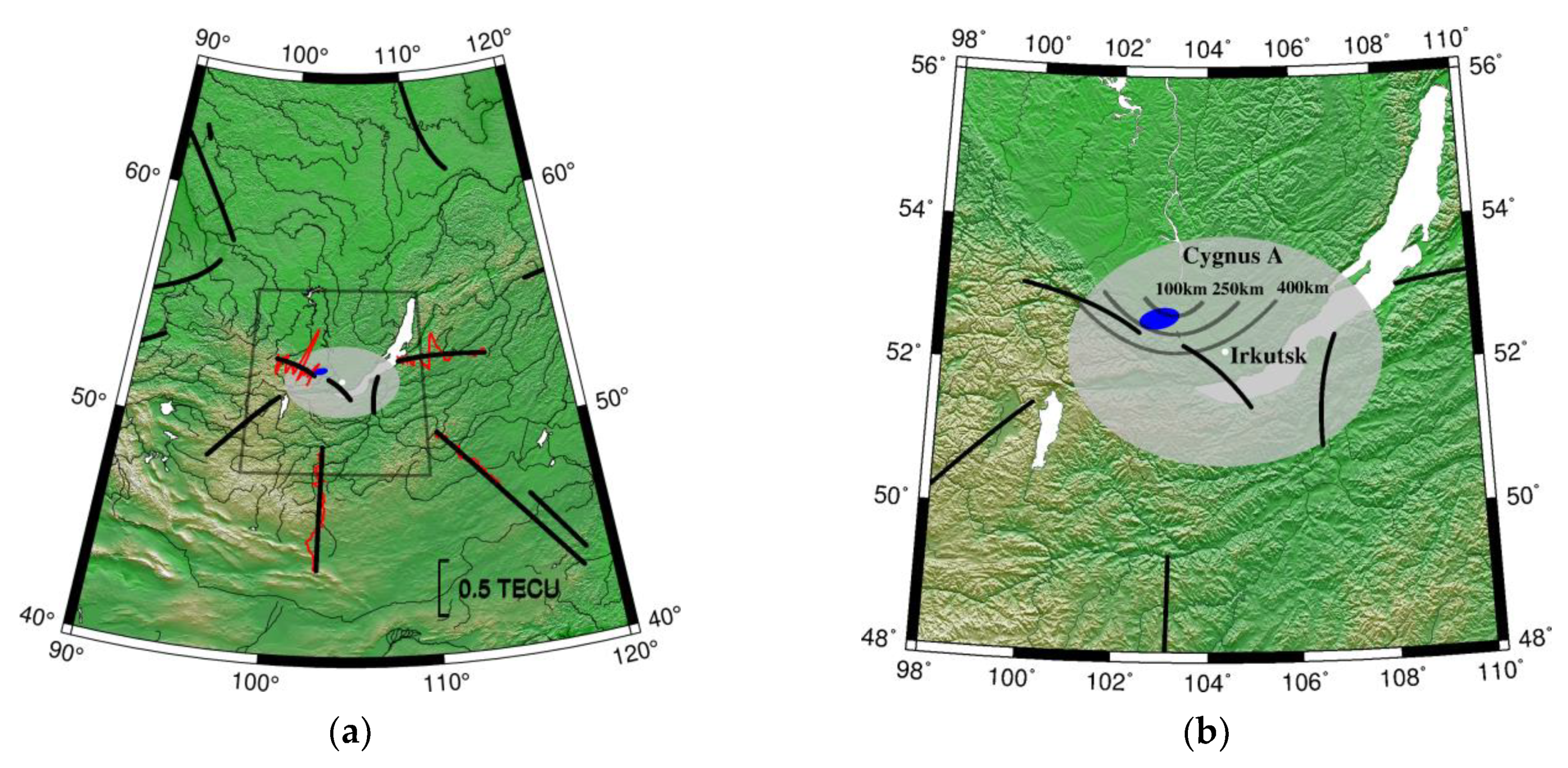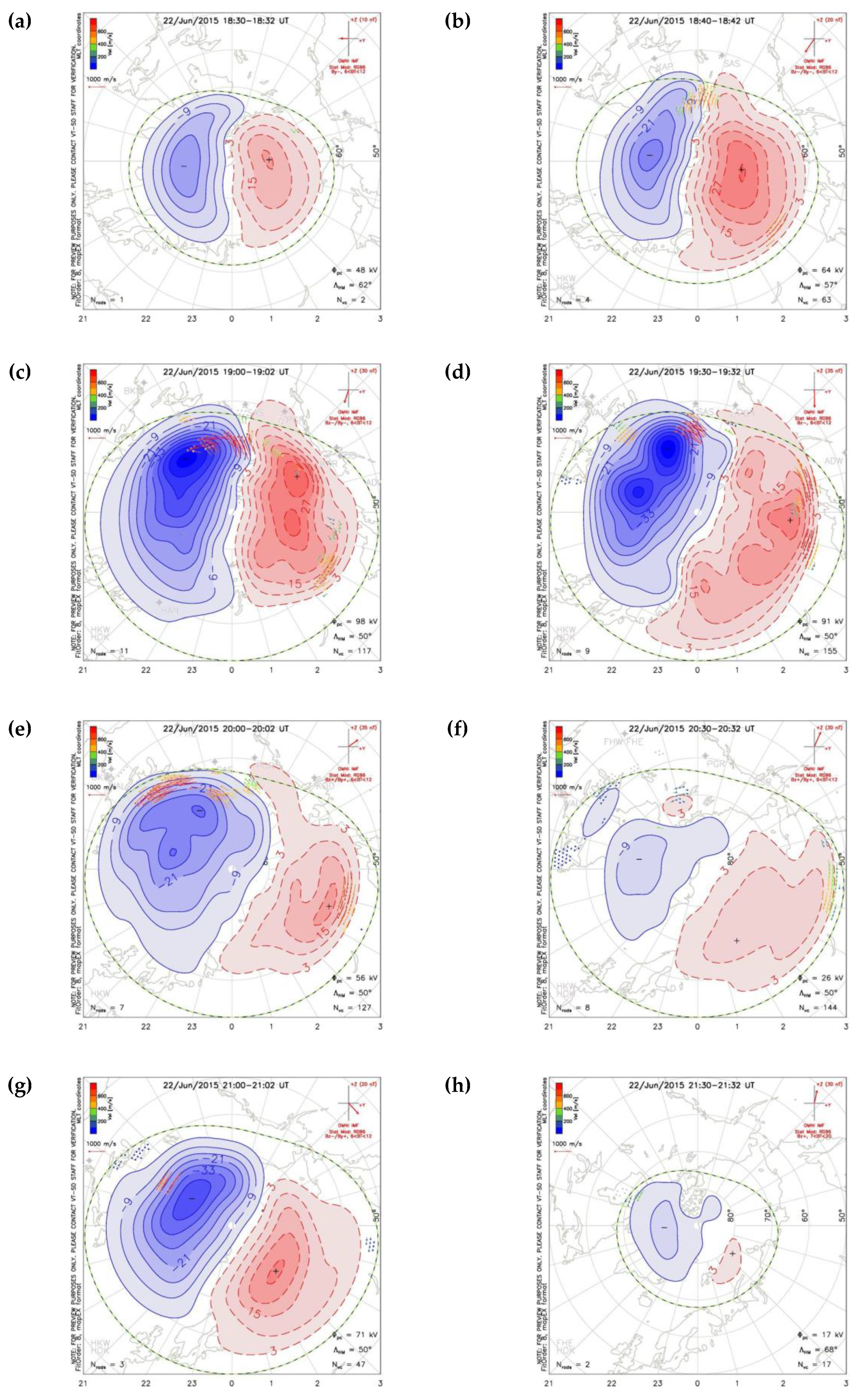Small-Scale Ionospheric Irregularities of Auroral Origin at Mid-latitudes during the 22 June 2015 Magnetic Storm and Their Effect on GPS Positioning
Abstract
1. Introduction
2. Experimental Facilities and Data
3. Results
3.1. 22 June 2015 Geomagnetic Storm
3.2. Spread-F and Scintillations
3.3. Precise Point Positioning
4. Discussion
5. Conclusions
Supplementary Materials
Author Contributions
Funding
Acknowledgments
Conflicts of Interest
References
- Yeh, K.C.; Liu, C.-H. Radio wave scintillations in the ionosphere. Proc. IEEE 1982, 70, 324–360. [Google Scholar] [CrossRef]
- Kintner, P.; Ledvina, B.M.; De Paula, E.R. GPS and ionospheric scintillations. Space Weather 2007, 5. [Google Scholar] [CrossRef]
- Aarons, J. Global morphology of ionospheric scintillations. Proc. IEEE 1982, 70, 360–378. [Google Scholar] [CrossRef]
- Hysell, D. An overview and synthesis of plasma irregularities in equatorial spread F. J. Atmos. Sol. Terr. Phys. 2000, 62, 1037–1056. [Google Scholar] [CrossRef]
- Hlubek, N.; Berdermann, J.; Wilken, V.; Gewies, S.; Jakowski, N.; Wassaie, M.; Damtie, B. Scintillations of the GPS, GLONASS, and Galileo signals at equatorial latitude. J. Space Weather Space Clim. 2014, 4. [Google Scholar] [CrossRef]
- Jiao, Y.; Morton, Y.; Taylor, S. Comparative studies of high-latitude and equatorial ionospheric scintillation characteristics of GPS signals. In Proceedings of the Position, Location and Navigation Symposium (PLANS 2014), Monterey, CA, USA, 5–8 May 2014; pp. 37–42. [Google Scholar] [CrossRef]
- Jiao, Y.; Morton, Y.J. Comparison of the effect of high-latitude and equatorial ionospheric scintillation on GPS signals during the maximum of solar cycle 24. Radio Sci. 2015, 50, 886–903. [Google Scholar] [CrossRef]
- Prikryl, P.; Jayachandran, P.T.; Chadwick, R.; Kelly, T.D. Climatology of GPS phase scintillation at northern high latitudes for the period from 2008 to 2013. Ann. Geophys. 2015, 33, 531–545. [Google Scholar] [CrossRef]
- Booker, H.G.; Wells, H.W. Scattering of radio waves by theF-region of the ionosphere. J. Geophys. Res. Space Phys. 1938, 43, 249. [Google Scholar] [CrossRef]
- Basu, S.; Kelley, M.C. A review of recent observations of equatorial scintillations and their relationship to current theories of Fregion irregularity generation. Radio Sci. 1979, 14, 471–485. [Google Scholar] [CrossRef]
- Woodman, R.F. Spread F—An old equatorial aeronomy problem finally resolved? Ann. Geophys. 2009, 27, 1915–1934. [Google Scholar] [CrossRef]
- Skone, S.H. The impact of magnetic storms on GPS receiver performance. J. Geod. 2001, 75, 457–468. [Google Scholar] [CrossRef]
- Afraimovich, E.; Astafyeva, E.; Demyanov, V.; Gamayunov, I. Mid-latitude amplitude scintillation of GPS signals and GPS performance slips. Adv. Space Res. 2009, 43, 964–972. [Google Scholar] [CrossRef]
- Astafyeva, E.; Yasyukevich, Y.; Maksikov, A.; Zhivetiev, I.V. Geomagnetic storms, super-storms, and their impacts on GPS-based navigation systems. Space Weather 2014, 12, 508–525. [Google Scholar] [CrossRef]
- Fridman, S. The formation of small-scale irregularities as a result of ionospheric plasma mixing by large-scale drifts. Planet. Space Sci. 1990, 38, 961–972. [Google Scholar] [CrossRef]
- Astafyeva, E.; Afraimovich, E.; Voeykov, S. Generation of secondary waves due to intensive large-scale AGW traveling. Adv. Space Res. 2008, 41, 1459–1462. [Google Scholar] [CrossRef]
- Bowman, G. A relationship between polar magnetic substorms, ionospheric height rises and the occurrence of spread-F. J. Atmos. Terr. Phys. 1978, 40, 713–722. [Google Scholar] [CrossRef]
- Ma, G.; Maruyama, T. A super bubble detected by dense GPS network at east Asian longitudes. Geophys. Res. Lett. 2006, 33. [Google Scholar] [CrossRef]
- Demyanov, V.; Yasyukevich, Y.; Ishin, A.; Astafyeva, E.I. Ionospheric super-bubble effects on the GPS positioning relative to the orientation of signal path and geomagnetic field direction. GPS Solut. 2011, 16, 181–189. [Google Scholar] [CrossRef]
- Mevius, M.; Tol, S.; Pandey, V.N.; Vedantham, H.K.; Brentjens, M.A.; Bruyn, A.G.; Abdalla, F.; Asad, K.M.B.; Bregman, J.D.; Brouw, W.N.; et al. Probing ionospheric structures using the LOFAR radio telescope. Radio Sci. 2016, 51, 927–941. [Google Scholar] [CrossRef]
- Vasilyev, R.V.; Kushnarev, D.; Lebedev, V.; Medvedev, A.; Nevidimov, N.; Ratovsky, K. Perspectives of usage of Irkutsk incoherent scatter radar (IISR) as an imaging riometer and radio-heliograph. J. Atmos. Sol. Terr. Phys. 2013, 105, 273–280. [Google Scholar] [CrossRef]
- Reiff, P.; Daou, A.G.; Sazykin, S.; Nakamura, R.; Hairston, M.R.; Coffey, V.; Chandler, M.O.; Anderson, B.J.; Russell, C.T.; Welling, D.; et al. Multispacecraft observations and modeling of the 22/23 June 2015 geomagnetic storm. Geophys. Res. Lett. 2016, 43, 7311–7318. [Google Scholar] [CrossRef]
- Astafyeva, E.; Zakharenkova, I.; Alken, P. Prompt penetration electric fields and the extreme topside ionospheric response to the 22–23 June 2015 geomagnetic storm as seen by the Swarm constellation. Earth Planets Space 2016, 68, 1309. [Google Scholar] [CrossRef]
- Astafyeva, E.; Zakharenkova, I.; Huba, J.D.; Doornbos, E.; Ijssel, J.V.D. Global Ionospheric and Thermospheric Effects of the June 2015 Geomagnetic Disturbances: Multi-Instrumental Observations and Modeling. J. Geophys. Res. Space Phys. 2017, 122, 11716–11742. [Google Scholar] [CrossRef] [PubMed]
- Astafyeva, E.; Zakharenkova, I.; Hozumi, K.; Alken, P.; Coïsson, P.; Hairston, M.R.; Coley, W.R. Study of the Equatorial and Low-Latitude Electrodynamic and Ionospheric Disturbances During the 22–23 June 2015 Geomagnetic Storm Using Ground-Based and Spaceborne Techniques. J. Geophys. Res. Space Phys. 2018, 123, 2424–2440. [Google Scholar] [CrossRef] [PubMed]
- Singh, R.; Sripathi, S. Ionospheric Response to 22–23 June 2015 Storm as Investigated Using Ground-Based Ionosondes and GPS Receivers Over India. J. Geophys. Res. Space Phys. 2017, 122, 645. [Google Scholar] [CrossRef]
- Piersanti, M.; Alberti, T.; Bemporad, A.; Berrilli, F.; Bruno, R.; Capparelli, V.; Carbone, V.; Cesaroni, C.; Consolini, G.; Cristaldi, A.; et al. Comprehensive Analysis of the Geoeffective Solar Event of 21 June 2015: Effects on the Magnetosphere, Plasmasphere, and Ionosphere Systems. Sol. Phys. 2017, 292, 5–169. [Google Scholar] [CrossRef]
- Gherm, V.E.; Zernov, N.; Strangeways, H. Effects of diffraction by ionospheric electron density irregularities on the range error in GNSS dual-frequency positioning and phase decorrelation. Radio Sci. 2011, 46. [Google Scholar] [CrossRef]
- Andrew, O.-O.A.; Doherty, P.H.; Carrano, C.S.; Valladares, C.E.; Groves, K.M. Impacts of ionospheric scintillations on GPS receivers intended for equatorial aviation applications. Radio Sci. 2012, 47. [Google Scholar] [CrossRef]
- Luo, X.; Gu, S.; Lou, Y.; Xiong, C.; Chen, B.; Jin, X. Assessing the Performance of GPS Precise Point Positioning Under Different Geomagnetic Storm Conditions during Solar Cycle 24. Sensors 2018, 18, 1784. [Google Scholar] [CrossRef]
- Fremouw, E.J.; Bates, H.F. Worldwide Behavior of Average VHF-UHF Scintillation. Radio Sci. 1971, 6, 863–869. [Google Scholar] [CrossRef]
- Fremouw, E.J.; Leadabrand, R.L.; Livingston, R.C.; Cousins, M.D.; Rino, C.L.; Fair, B.C.; Lang, R.A. Early results from the DNA Wideband satellite experiment—Complex-signal scintillation. Radio Sci. 1978, 13, 167–187. [Google Scholar] [CrossRef]
- Berkner, L.V.; Wells, H.W. F-region ionosphere-investigations at low latitudes. J. Geophys. Res. Space Phys. 1934, 39, 215. [Google Scholar] [CrossRef]
- Reinisch, B.; Haines, D.M.; Bibl, K.; Galkin, I.; Kitrosser, D.F.; Sales, G.S.; Scali, J.L.; Huang, X. Ionospheric sounding in support of over-the-horizon radar. Radio Sci. 1997, 32, 1681–1694. [Google Scholar] [CrossRef]
- Potekhin, A.P.; Medvedev, A.; Zavorin, A.V.; Kushnarev, D.S.; Lebedev, V.P.; Shpynev, B.G. Development of diagnostic capabilities of the Irkutsk incoherent scattering radar. Cosmo Res. 2008, 46, 347–353. [Google Scholar] [CrossRef]
- Shanmugam, S.; Jones, J.; Macaulay, A.; Van Dierendonck, A. Evolution to modernized GNSS ionoshperic scintillation and TEC monitoring. In Proceedings of the 2012 IEEE/ION Position, Location and Navigation Symposium; Institute of Electrical and Electronics Engineers (IEEE), Myrtle Beach, South Carolina, USA, 23–26 April 2012; pp. 265–273. [Google Scholar]
- Spogli, L.; Alfonsi, L.; De Franceschi, G.; Romano, V.; Aquino, M.H.O.; Dodson, A. Climatology of GPS ionospheric scintillations over high and mid-latitude European regions. Ann. Geophys. 2009, 27, 3429–3437. [Google Scholar] [CrossRef]
- Hofmann-Wellenhof, B.; Lichtenegger, H.; Collins, J. Global Positioning System; Springer Science and Business Media LLC: Berlin, Germany, 2001. [Google Scholar]
- Jin, S.; Feng, G.; Gleason, S. Remote sensing using GNSS signals: Current status and future directions. Adv. Space Res. 2011, 47, 1645–1653. [Google Scholar] [CrossRef]
- Afraimovich, E.L.; Astafyeva, E.I.; Demyanov, V.; Edemskiy, I.K.; Gavrilyuk, N.S.; Ishin, A.; Kosogorov, E.A.; Leonovich, L.A.; Lesyuta, O.S.; Palamartchouk, K.; et al. A review of GPS/GLONASS studies of the ionospheric response to natural and anthropogenic processes and phenomena. J. Space Weather Space Clim. 2013, 3, A27. [Google Scholar] [CrossRef]
- Dow, J.M.; Neilan, R.E.; Rizos, C. The International GNSS Service in a changing landscape of Global Navigation Satellite Systems. J. Geod. 2009, 83, 191–198. [Google Scholar] [CrossRef]
- Яcюкeвич, Ю.; Yasyukevich, Y.; Пeрeвaлoвa, Н.; Perevalova, N.; Becнин, A.; Vesnin, A. SibNet—Siberian Global Navigation Satellite System Network: Current state. Sol. Terr. Phys. 2018, 4, 63–72. [Google Scholar] [CrossRef]
- Jayachandran, P.T.; Langley, R.B.; MacDougall, J.W.; Mushini, S.C.; Pokhotelov, D.; Hamza, A.M.; Mann, I.R.; Milling, D.K.; Kale, Z.C.; Chadwick, R.; et al. Canadian High Arctic Ionospheric Network (CHAIN). Radio Sci. 2009, 44. [Google Scholar] [CrossRef]
- Bruyninx, C.; Habrich, H.; Söhne, W.; Kenyeres, A.; Stangl, G.; Völksen, C. Enhancement of the EUREF Permanent Network Services and Products. In International Association of Geodesy Symposia; Springer Science and Business Media LLC: Berlin, Germany, 2011; Volume 136, pp. 27–34. [Google Scholar]
- Maletckii, B.; Yasyukevich, Y.; Vesnin, A. Wave Signatures in Total Electron Content Variations: Filtering Problems. Remote Sens. 2020, 12, 1340. [Google Scholar] [CrossRef]
- Schaer, S. Mapping and Predicting the Earth’s Ionosphere Using the Global Positioning System. Ph.D. Dissertation, Astronomical Institute, University of Berne, Berne, Switzerland, 25 March 1999. [Google Scholar]
- Yasyukevich, Y.; Kiselev, A.V.; Zhivetiev, I.V.; Edemskiy, I.K.; Syrovatskii, S.V.; Maletckii, B.M.; Vesnin, A.M. SIMuRG: System for Ionosphere Monitoring and Research from GNSS. GPS Solut. 2020, 24, 1–12. [Google Scholar] [CrossRef]
- Zhou, F.; Dong, D.; Li, W.; Jiang, X.; Wickert, J.; Schuh, H. GAMP: An open-source software of multi-GNSS precise point positioning using undifferenced and uncombined observations. GPS Solut. 2018, 22, 33. [Google Scholar] [CrossRef]
- Yasyukevich, Y.; Astafyeva, E.; Padokhin, A.; Ivanova, V.A.; Syrovatskii, S.; Podlesnyi, A. The 6 September 2017 X-Class Solar Flares and Their Impacts on the Ionosphere, GNSS, and HF Radio Wave Propagation. Space Weather 2018, 16, 1013–1027. [Google Scholar] [CrossRef]
- Mathews, G.J.; Towheed, S.S. NSSDC OMNIWeb: The first space physics WWW-based data browsing and retrieval system. Comput. Netw. ISDN Syst. 1995, 27, 801–808. [Google Scholar] [CrossRef]
- Thebault, E.; Finlay, C.C.; Beggan, C.D.; Alken, P.; Aubert, J.; Barrois, O.; Bertrand, F.; Bondar, T.; Boness, A.; Brocco, L.; et al. International Geomagnetic Reference Field: The 12th generation. Earth Planets Space 2015, 67, 68. [Google Scholar] [CrossRef]
- Vasilyev, R.V.; Globa, M.; Kushnarev, D.; Medvedev, A.; Ratovsky, K.; Globa, M. Spectral characteristics of ionospheric scintillations of VHF radiosignal near magnetic zenith. J. Atmos. Sol. Terr. Phys. 2017, 160, 48–55. [Google Scholar] [CrossRef]
- Crane, R.K. Spectra of ionospheric scintillation. J. Geophys. Res. Space Phys. 1976, 81, 2041–2050. [Google Scholar] [CrossRef]
- Kelley, M.C.; Vickrey, J.F.; Carlson, C.W.; Torbert, R. On the origin and spatial extent of high-latitudeFregion irregularities. J. Geophys. Res. Space Phys. 1982, 87, 4469. [Google Scholar] [CrossRef]
- Kelley, M.C. 10 Instabilities and Structure in the High-Latitude Ionosphere. Int. Geophys. 2009, 96, 469–544. [Google Scholar] [CrossRef]
- Kagan, L.M.; Myasnikov, E.N.; Kosolapenko, V.I.; Kryazhev, V.A.; Cheremnyj, V.A.; Persson, M.A. F-layer irregularities’ formation at auroral latitudes: Radio wave scintillation and EISCAT observations. J. Atmos. Terr. Phys. 1995, 57, 917–928. [Google Scholar] [CrossRef]
- Bowman, G.G. Periodicities and spread-F associated with largescale travelling ionospheric disturbances. Indian J. Radio Space Phys. 1996, 25, 93–100. Available online: http://nopr.niscair.res.in/handle/123456789/35645 (accessed on 16 April 2020).
- Bowman, G.G.; Mortimer, I.K. Some characteristics of large-scale travelling ionospheric disturbances and a relationship between the F2 layer height rises of these disturbances and equatorial pre-sunrise events. Ann. Geophys. 2010, 28, 1419–1430. [Google Scholar] [CrossRef]
- Farley, D.T.; Balsey, B.B.; Woodman, R.F.; McClure, J.P. Equatorial spreadF: Implications of VHF radar observations. J. Geophys. Res. Space Phys. 1970, 75, 7199–7216. [Google Scholar] [CrossRef]
- Hysell, D.; Larsen, M.; Fritts, D.; Laughman, B.; Sulzer, M. Major upwelling and overturning in the mid-latitude F region ionosphere. Nat. Commun. 2018, 9, 3326. [Google Scholar] [CrossRef]
- Newell, P.T.; Sotirelis, T.; Wing, S. Diffuse, monoenergetic, and broadband aurora: The global precipitation budget. J. Geophys. Res. Space Phys. 2009, 114. [Google Scholar] [CrossRef]
- Chisham, G.; Lester, M.; Milan, S.E.; Freeman, M.P.; Bristow, W.A.; Grocott, A.; McWilliams, K.A.; Ruohoniemi, J.M.; Yeoman, T.K.; Dyson, P.L.; et al. A decade of the Super Dual Auroral Radar Network (SuperDARN): Scientific achievements, new techniques and future directions. Surv. Geophys. 2007, 28, 33–109. [Google Scholar] [CrossRef]








© 2020 by the authors. Licensee MDPI, Basel, Switzerland. This article is an open access article distributed under the terms and conditions of the Creative Commons Attribution (CC BY) license (http://creativecommons.org/licenses/by/4.0/).
Share and Cite
Yasyukevich, Y.; Vasilyev, R.; Ratovsky, K.; Setov, A.; Globa, M.; Syrovatskii, S.; Yasyukevich, A.; Kiselev, A.; Vesnin, A. Small-Scale Ionospheric Irregularities of Auroral Origin at Mid-latitudes during the 22 June 2015 Magnetic Storm and Their Effect on GPS Positioning. Remote Sens. 2020, 12, 1579. https://doi.org/10.3390/rs12101579
Yasyukevich Y, Vasilyev R, Ratovsky K, Setov A, Globa M, Syrovatskii S, Yasyukevich A, Kiselev A, Vesnin A. Small-Scale Ionospheric Irregularities of Auroral Origin at Mid-latitudes during the 22 June 2015 Magnetic Storm and Their Effect on GPS Positioning. Remote Sensing. 2020; 12(10):1579. https://doi.org/10.3390/rs12101579
Chicago/Turabian StyleYasyukevich, Yury, Roman Vasilyev, Konstantin Ratovsky, Artem Setov, Maria Globa, Semen Syrovatskii, Anna Yasyukevich, Alexander Kiselev, and Artem Vesnin. 2020. "Small-Scale Ionospheric Irregularities of Auroral Origin at Mid-latitudes during the 22 June 2015 Magnetic Storm and Their Effect on GPS Positioning" Remote Sensing 12, no. 10: 1579. https://doi.org/10.3390/rs12101579
APA StyleYasyukevich, Y., Vasilyev, R., Ratovsky, K., Setov, A., Globa, M., Syrovatskii, S., Yasyukevich, A., Kiselev, A., & Vesnin, A. (2020). Small-Scale Ionospheric Irregularities of Auroral Origin at Mid-latitudes during the 22 June 2015 Magnetic Storm and Their Effect on GPS Positioning. Remote Sensing, 12(10), 1579. https://doi.org/10.3390/rs12101579







